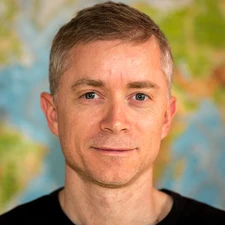David L. Egholm

The 2019 Ralph Alger Bagnold Medal is awarded to David L. Egholm for shaping our thinking about glacial landscape evolution by effectively addressing many topical, big-picture problems through the judicious use of numerical models.
David Lundbek Egholm is a global leader in the field of quantitative glacial landform-evolution modelling. After a decade of research in crustal geodynamics, he put his background in physics and computational modelling to work by addressing first-order questions in glacial geomorphology. He recognised early after this transition that the models developed up to then were not sufficient for describing glacier flow and bedrock erosion in mountain belts. Egholm wrote his own adaptive finite-volume solver for ice sheets and glaciers and rapidly developed a glacial dynamics model that retained the key parts of the stress tensor required to adequately model glacier flow in steep mountains. At that point he was already largely ahead of other glacial geomorphologists with similar modelling objectives, despite starting from scratch with his own code. Since then he has continued to extend the utility of his model by adding more realistic physics for glacier sliding, bedrock erosion, and sub-glacial hydrology. This effort has allowed testing of hypotheses regarding interactions between glaciers, climate, and topography that would not have been possible otherwise and has led to a series of outstanding articles in leading journals. He has significantly advanced our understanding of landscape evolution in high mountain regions and made very significant and high-impact contributions explaining how glacial landforms evolve over several cycles of glaciation, how glacial, periglacial, and fluvial processes interact in bedrock erosion, and how erosion limits mountain height. His studies have illuminated the origin of classical – yet hitherto poorly understood – bedrock erosional landforms carved by ice and water.
In his approach Egholm identifies essential physical processes underlying geomorphological problems through meticulous analytical thinking, and employs an exceptionally rigorous computational approach to gain novel and fundamental insights into longstanding problems. Essential for his work is his ability to recognise technological advances and translate these to geomorphology. Egholm is a pioneer, an innovator, a promoter, and a great communicator who has inspired many geomorphologists worldwide. Following a series of cutting-edge publications in Nature, the highly advanced numerical models developed by him and his students have been successfully tested and verified by numerous other working groups across multiple geographical areas, clearly demonstrating the universal character of his research. The exceptional value of Egholm’s approach to geomorphology is bridging the gaps between the disciplines of physical geography, geology, physics, mathematics, computational science and stratigraphy, leading to a sound and testable, holistic vision of Earth-surface processes. This makes him a very worthy recipient of the Ralph Alger Bagnold Medal.
